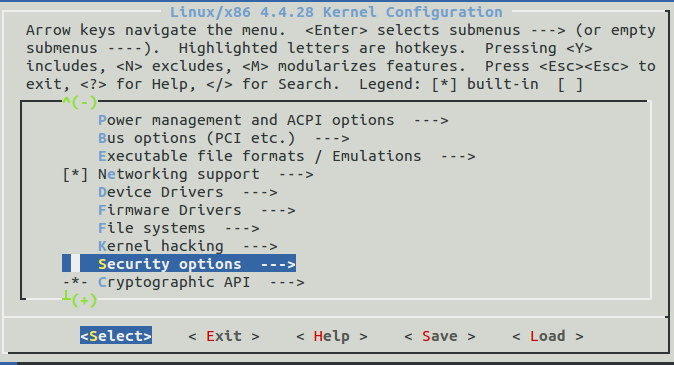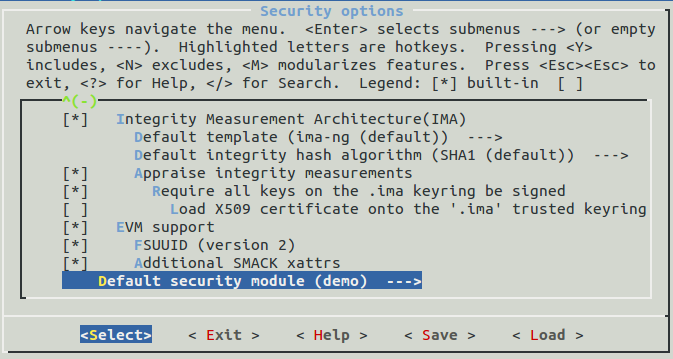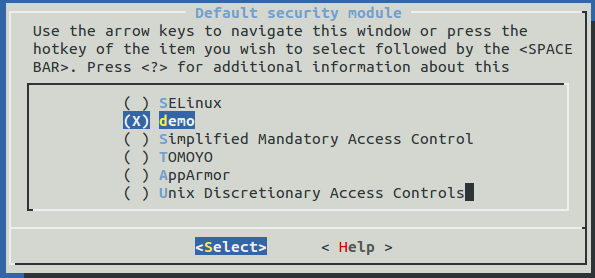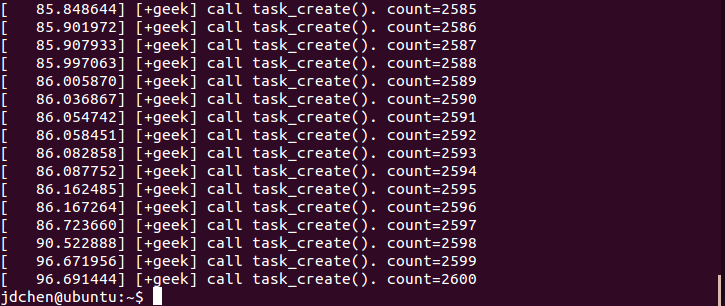学习LSM(Linux security module)之二:编写并运行一个简单的demo
各种折腾,经过了一个蛋疼的周末,终于在Ubuntu14.04上运行了一个基于LSM的简单demo程序。
一:程序编写
先简单的看一下这个demo:
//demo_lsm.c
#include <linux/lsm_hooks.h>
#include <linux/sysctl.h> static unsigned long long count = ; int demo_task_create(unsigned long clone_flags)
{
printk("[+geek] call task_create(). count=%llu\n", ++count);
return ;
} static struct security_hook_list demo_hooks[] = {
LSM_HOOK_INIT(task_create,demo_task_create),
};
void __init demo_add_hooks(void)
{
pr_info("Demo: becoming mindful.\n"); //打印相关信息,可以通过dmesg | grep Yama:查看
security_add_hooks(demo_hooks, ARRAY_SIZE(demo_hooks)); //添加安全模块函数
} static __init int demo_init(void){
demo_add_hooks();
return ;
} security_initcall(demo_init);
根据(一)的yama可以得出,编写一个基于LSM的安全模块的基本流程:
1>确定需要hook的函数
2>对hook函数进行填充,添加自己的逻辑(安全检查)
3>添加到在security_hook_list的数据结构里
4>对这个有注册逻辑的函数进行注册
1:确定需要hook的函数:
1>用户创建进程需要调用系统调用 sys_fork()/sys_vfork()/sys_clone()
2>sys_fork()等函数中调用 do_fork()
3>do_fork()调用copy_process()
4>copy_process()调用security_task_create(),这里便是hook点了,可以进行自己的逻辑
5>security_task_create()的主体就是security_hook_list的task_create()
2:对hook函数进行必要的填充,添加自己的逻辑(额外的安全检查)
在这里,只是为了简单的检测自己的代码是否能够正常运行,所以,只用了简单的printk,详情请看demo_task_create函数。
3:添加到在security_hook_list的数据结构里
额外说一点:关于这一步,在4.0之前后某个版本,打了个补丁,所以实现方式会有不同,先看一下4.0以前:
struct security_operations {
char name[SECURITY_NAME_MAX + ];
int (*ptrace_access_check) (struct task_struct *child, unsigned int mode);
int (*ptrace_traceme) (struct task_struct *parent);
int (*capget) (struct task_struct *target, kernel_cap_t *effective, kernel_cap_t *inheritable, kernel_cap_t *permitted);
int (*capset) (struct cred *new, const struct cred *old, const kernel_cap_t *effective, const kernel_cap_t *inheritable, const kernel_cap_t *permitted);
int (*capable) (const struct cred *cred, struct user_namespace *ns, int cap, int audit);
int (*quotactl) (int cmds, int type, int id, struct super_block *sb);
....
这种实现方式有个缺点,无论hook几个函数,都会替每个指针占一个位置,由于内核空间,内存十分宝贵,这种占空间西行为产生了很大的浪费。所以实现换了一种方式,如下:
struct security_hook_list {
struct list_head list;
struct list_head *head;
union security_list_options hook;
};
然后,security_list_options以一种联结体的方式存在,然后通过侵入式链表连接,可以有效的节省空间。
言归正传。数据结构可以通过LSM_HOOK_INIT宏来进行填充,详情可以看(一):
4:对这个有注册逻辑的函数进行注册
在这一点上,简单的security_initcall(demo_init);就可以了
二:Makefile和Kconfig编写
在编写这两个文件时,由于在2.6.X后,lsm的模块不允许通过insmod动态加载到内核中,需要在编译内核时添加,所以,需要谨慎,否则容易出错(-_-)。
如下:
//Kconfig
config SECURITY_DEMO
bool "demo support"
depends on SECURITY
default n
help
introduction of demo modules
//Makefile
obj-$(CONFIG_SECURITY_GEEK) := demo.o
demo-y := demo_lsm.o
将这两个文件以及前文的 demo_lsm.c 放到./linux-X.X.X(X.X.X>4.0.0)/security/demo(自己创建)中,然后修改security下的Kconfig和Makefile,这里可以参照SElinux或者yama的格式进行编写, 但需要注意的是,在Linux>4.2之后,Yama默认只能依附在其它模块上,所以,最好对照SELinux。
#
# Makefile for the kernel security code
# obj-$(CONFIG_KEYS) += keys/
subdir-$(CONFIG_SECURITY_SELINUX) += selinux
subdir-$(CONFIG_SECURITY_DEMO) += demo
subdir-$(CONFIG_SECURITY_SMACK) += smack
subdir-$(CONFIG_SECURITY_TOMOYO) += tomoyo
subdir-$(CONFIG_SECURITY_APPARMOR) += apparmor
subdir-$(CONFIG_SECURITY_YAMA) += yama # always enable default capabilities
obj-y += commoncap.o
obj-$(CONFIG_MMU) += min_addr.o # Object file lists
obj-$(CONFIG_SECURITY) += security.o
obj-$(CONFIG_SECURITYFS) += inode.o
obj-$(CONFIG_SECURITY_SELINUX) += selinux/
obj-$(CONFIG_SECURITY_DEMO) += demo/
obj-$(CONFIG_SECURITY_SMACK) += smack/
obj-$(CONFIG_AUDIT) += lsm_audit.o
obj-$(CONFIG_SECURITY_TOMOYO) += tomoyo/
obj-$(CONFIG_SECURITY_APPARMOR) += apparmor/
obj-$(CONFIG_SECURITY_YAMA) += yama/
obj-$(CONFIG_CGROUP_DEVICE) += device_cgroup.o # Object integrity file lists
subdir-$(CONFIG_INTEGRITY) += integrity
obj-$(CONFIG_INTEGRITY) += integrity/
#
# Security configuration
# menu "Security options" source security/keys/Kconfig ..... source security/selinux/Kconfig
source security/demo/Kconfig
source security/smack/Kconfig
source security/tomoyo/Kconfig
source security/apparmor/Kconfig
source security/yama/Kconfig source security/integrity/Kconfig choice
prompt "Default security module"
default DEFAULT_SECURITY_SELINUX if SECURITY_SELINUX
default DEFAULT_SECURITY_DEMO if SECURITY_DEMO
default DEFAULT_SECURITY_SMACK if SECURITY_SMACK
default DEFAULT_SECURITY_TOMOYO if SECURITY_TOMOYO
default DEFAULT_SECURITY_APPARMOR if SECURITY_APPARMOR
default DEFAULT_SECURITY_DAC help
Select the security module that will be used by default if the
kernel parameter security= is not specified. config DEFAULT_SECURITY_SELINUX
bool "SELinux" if SECURITY_SELINUX=y config DEFAULT_SECURITY_DEMO
bool "demo" if SECURITY_DEMO=y config DEFAULT_SECURITY_SMACK
bool "Simplified Mandatory Access Control" if SECURITY_SMACK=y config DEFAULT_SECURITY_TOMOYO
bool "TOMOYO" if SECURITY_TOMOYO=y config DEFAULT_SECURITY_APPARMOR
bool "AppArmor" if SECURITY_APPARMOR=y config DEFAULT_SECURITY_DAC
bool "Unix Discretionary Access Controls" endchoice config DEFAULT_SECURITY
string
default "selinux" if DEFAULT_SECURITY_SELINUX
default "demo" if DEFAULT_SECURITY_DEMO
default "smack" if DEFAULT_SECURITY_SMACK
default "tomoyo" if DEFAULT_SECURITY_TOMOYO
default "apparmor" if DEFAULT_SECURITY_APPARMOR
default "" if DEFAULT_SECURITY_DAC endmenu
三:编译安装运行内核
1>将linux内核源码和二里面添加和更改的部分移到 /usr/src中。
2> cp /boot/config-‘uname -r’ /usr/src/kernels/linux3.2.14/.config,将原系统内核配置拷贝到需要编译的源码上
3> make menuconfig,这里可能会失败,这时候,你需要去apt-get install libncurses5-dev:截图如下:



在配置上,需要自己根据自己的水平来进行配置,否则极易弄巧成拙(-_-)
4>make bzImage -jN(N为具体数字,代表线程数),可以根据虚拟机内核数 X2来确定N的具体值,以节约时间
5>make modules -jN,同上
6>make modules_install
7>make install
8>部分可能需要修改grub的default为0,经测ubuntu14.04自动修改了,不需要自己去改
9>reboot ,并且demesg,可以得到如下:

demo就运行成功了
学习LSM(Linux security module)之二:编写并运行一个简单的demo的更多相关文章
- 学习LSM(Linux security module)之四:一个基于LSM的简单沙箱的设计与实现
嗯!如题,一个简单的基于LSM的沙箱设计.环境是Linux v4.4.28.一个比较新的版本,所以在实现过程中很难找到资料,而且还有各种坑逼,所以大部分的时间都是在看源码,虽然写的很烂,但是感觉收获还 ...
- 学习LSM(Linux security module)之一:解读yama
最近打算写一个基于LSM的安全模块,发现国内现有的资料极少.因此打算自己琢磨一下.大致的学习路线如下: 由易至难使用并阅读两到三个安全模块->参照阅读模块自己实现一个安全模块->在自己实现 ...
- 学习LSM(Linux security module)之三:Apparmor的前世今生和基本使用
感冒了,感觉一脑子浆糊,真是蛋疼. 先粗略讲一些前置知识. 一:MAC和DAC DAC(Discretionary Access Control),自主访问控制,是最常用的一类访问控制机制,意思为主体 ...
- Linux环境下部署完JDK后运行一个简单的Java程序
前言 前一篇文章详细讲解了如何在Windows环境下安装虚拟机+Linux系统,并且成功部署了JDK. 不过部署完JDK之后,我们判断部署是否成功的依据是看"java -version&qu ...
- Linux LSM(Linux Security Modules) Hook Technology
目录 . 引言 . Linux Security Module Framework Introduction . LSM Sourcecode Analysis . LSMs Hook Engine: ...
- linux security module机制
linux security module机制 概要 Hook机制,linux MAC的通用框架,可以使用SElinux, AppArmor,等作为不同安全框架的实现
- tensorflow笔记(二)之构造一个简单的神经网络
tensorflow笔记(二)之构造一个简单的神经网络 版权声明:本文为博主原创文章,转载请指明转载地址 http://www.cnblogs.com/fydeblog/p/7425200.html ...
- linux设备驱动第三篇:写一个简单的字符设备驱动
在linux设备驱动第一篇:设备驱动程序简介中简单介绍了字符驱动,本篇简单介绍如何写一个简单的字符设备驱动.本篇借鉴LDD中的源码,实现一个与硬件设备无关的字符设备驱动,仅仅操作从内核中分 ...
- 《Linux内核分析》第三周 构建一个简单的Linux系统MenuOS
[刘蔚然 原创作品转载请注明出处 <Linux内核分析>MOOC课程http://mooc.study.163.com/course/USTC-1000029000] WEEK THREE ...
随机推荐
- Android逆向之旅---静态方式分析破解视频编辑应用「Vue」水印问题
一.故事背景 现在很多人都喜欢玩文艺,特别是我身边的UI们,拍照一分钟修图半小时.就是为了能够在朋友圈显得逼格高,不过的确是挺好看的,修图的软件太多了就不多说了,而且一般都没有水印啥的.相比较短视频有 ...
- C++——设计模式说明
一.设计模式6大原则 名称 解释0.单一职责原则(SRP) 就一个类而言,应该仅有一个引起它变化的原因.一."开放-封闭"原则(OCP) 在软件设计模式中,这种不能修改,但可以扩展 ...
- [poj 2796]单调栈
题目链接:http://poj.org/problem?id=2796 单调栈可以O(n)得到以每个位置为最小值,向左右最多扩展到哪里. #include<cstdio> #include ...
- ionic改tab文字和icon图片的颜色
The official way would be: Change in your theme/variables.scss Active icon for tabs on android is: $ ...
- PHP设计模式-工厂模式、单例模式、注册模式
本文参考慕课网<大话PHP设计模式>-第五章内容编写,视频路径为:http://www.imooc.com/video/4876 推荐阅读我之前的文章:php的设计模式 三种基本设计模式, ...
- 新手如何更换自己喜欢的背景以及此背景的css码
以下内容为转载(对于css码可以自己写当然也可以去网上搜现成的): 更换背景教学:https://jingyan.baidu.com/album/fc07f9897c730412ffe519c0.ht ...
- (转)如何用python抓取网页并提取数据
最近一直在学这部分,今日发现一篇好文,虽然不详细,但是轮廓是出来了: 来自crifan:http://www.crifan.com/crawl_website_html_and_extract_inf ...
- oracle中函数
一:前言 最近决定每天都把知识点总结下,然后每个星期把知识点在进行分类发表日志. 二:The Question (1):在oracle中进行年龄的计算,知道出生日期进行计算后截取,本来是一个很简单的函 ...
- 基于js的地理数据的几何运算turfjs
Doc: http://turfjs.org/static/docs/global.html Openlayers3 Sample: http://jsfiddle.net/d6o81vc7/
- 【BZOJ3680】吊打xxx [模拟退火]
吊打XXX Time Limit: 10 Sec Memory Limit: 128 MB[Submit][Status][Discuss] Description gty又虐了一场比赛,被虐的蒟蒻 ...
